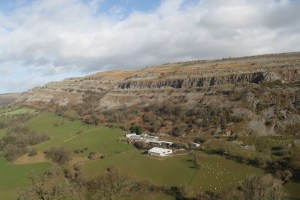This blog was first published on Howard Williams’sArchaeodeath blog.
As a recon. trip for the Past in its Place project, Dr Patricia Murrieta-Flores and I took a look at some of its more famous sites in the Vale of Llangollen where archaeology, folklore and literary culture collide. We visited Valle Crucis and the Pillar of Eliseg and considered their roles and relationship as sites of memory since the early Middle Ages. We also visited two other sites of interest to the project.
We scaled the heights of the prehistoric hillfort and medieval castle: Castell Dinas Brân. This short-lived thirteenth century castle is intriguing because its prominent situation within the Vale and traces of earlier occupation allude to a possible prehistoric and early medieval life before it was a castle.
It also has a fascinating biography, attracting folklore associated with giants, bardic poetry and, from the mid-18th and 19th centuries, travel literature and art recording and celebrating its sublime character.
We explored the ruins and the minimalist heritage signboard, before looking at modern traces of commemoration persisting at the site.
First, there are the arrangements of stones used to map out messages by visitors. Second, there is a tree, clearly a focus of commemoration and perhaps ash-scatterings. Third, there is a location, this time unmarked, but where previously I have noticed is a favourite location for ash scatterings.
Second, we visited Plas Newydd. Home to the Ladies of Llangollen – Butler and Ponsonby – for over 40 years, it served as a hub for the fostering Romantic movement in Llangollen. The house is situated in an antiquarian landscape where the past was imagined and fostered through landscape and retrieved material culture.
While the house is closed until April, there is an overtly commemorative component is the house itself on its outside: other of the Ladies’ names. Hence, through the display of its contents and its external names, serves as a form of funerary monument for the Ladies and their Romantic patronage for the arts in the Vale. Their gravestones are also commemorative, translated from St Collen’s churchyard to the Llangollen Museum.
Within the grounds, as devleoped by Butler and Ponsonby and their successors, key antiquarian features include a stone circle and relocated medieval churchyard cross, and a font brought from Valle Crucis Abbey and framed by a poem by the Ladies.
So here in the Vale we have juxtaposed the medieval ruin and a landscape recreated from medieval ruins. Together, they constitute elements of the antiquarian landscape of memory constructed during the later eighteenth and early nineteenth centuries in the Vale, a process that implicated both Valle Crucis and the Pillar of Eliseg.








